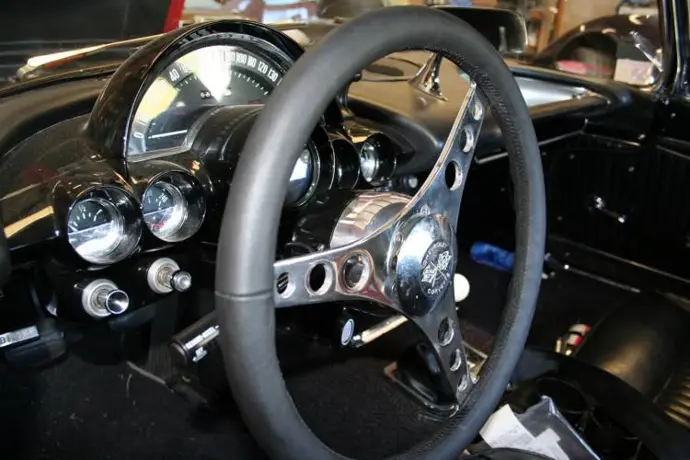Steering Response
Turns Lock to Lock vs. Overall Steering Ratio
This can be potentially confusing since some prefer to express steering response as an overall steering ratio, which would typically be around 16:1 on a car with traditionally “quick” steering. This ratio is calculated by measuring how many degrees of wheel movement results from one turn of the steering wheel. In the example above on full steering wheel turn (360 degrees) and with an overall steering ratio of 16:1 will yield 22.5 degrees of wheel rotation about the spindle since 360 degrees (in one rotation) divided by 22.5 degrees of measured travel=16, or a 16:1 ratio .
What do we mean when we say turns “lock to lock”? Lock being the hard stop where the steering wheel will not turn when rotated in each direction. We prefer using the lock to lock number because it is a lot easier for you to hop in your car, count the turns of the wheel when rotated all the way from one lock to the opposite lock, than to put your cars front tire on a degree table and measure angular rotation of the tire and wheel about the spindle with one turn of the steering wheel.
An example of how simple this is can be illustrated by using our development car, a 1964 Mustang. The factory stock car without power steering was five+ turns of the steering wheel lock to lock! A handful when trying to maneuver quickly; no fun at all. With our Steeroids power rack and pinion kit installed and no changes to the stock steering arms the driver now makes 2.5 turns lock to lock. This increases the response of the vehicle significantly, yet not to the point of being “twitchy” and subject to over control. No more wild antics just to get the car to turn, just move the wheel a bit and you are turning!
NOTE: It is important know that power steering boost has nothing to do with the overall steering ratio.
Steering Feedback
All of the previous discussion about feel and on center feel is the basis to understand steering feedback. From the basic design limitations of a steering box it is easy to explain why a car with this system has very imprecise feedback to the driver. All the force necessary for you to feel what the car is doing is absorbed in rotary joints and linkage needed to make the system work. If you add wear on those joints you have a steering system that is ambiguous to drive, it is not “telling” you what you really need to know. This is especially true if you are cornering hard up to the limit of available traction. The last thing you want when the tires are howling is to have no clue what the front end is doing.
Feedback is also affected by the amount of boost your power steering has, if so equipped. This is why a few drivers prefer manual steering over power, but that does not need to be the case. A properly designed power steering system is just as good if not better that a manual system. For one thing fatigue is a factor. That is why most race cars have power assisted steering. Make sure you consider the amount of boost you will get if you are converting. There are ways to limit this with certain pumps. It is well worth the effort to have a car that handles well at speed and that you can easily maneuver to park with the added friction of wide tires, so don’t dismiss the power steering option.
It’s Time to Update!
Classic cars have that iconic look that we all love but they drive like a dump truck! You now know that a steering box has serious technical limitations that can not be corrected by just a steering system rebuild. Even when your car was new the steering box did not provide either the proper steering ratio, feel, on center feel, or feedback that have become the hallmark of a modern steering system. We now take for granted how a modern car should feel. Driving a classic convinces us that something has drastically changed in steering technology since the car was designed, and its time to update.
Rebuilding is time consuming and expensive and the result is the same old technology “refreshed”. Here are some of the benefits of a rack and pinion conversion to consider:
- Truly a modification that is really gratifying; you can easily feel the results.
- Vastly improved handling that technically is not possible with outdated steering boxes.
- Tames the beast – makes the car more drivable and fun to be in.
- Modernization of your classics steering to take advantage of a superior and newer technology.
- Improves your competitive advantage if you road race or auto-cross.
- A rack and pinion conversion is easy to install, and will not eliminate the ability to return the car to factory stock steering if necessary. No drilling, welding, cutting whatsoever.
- Enhances the vehicles resale value.
